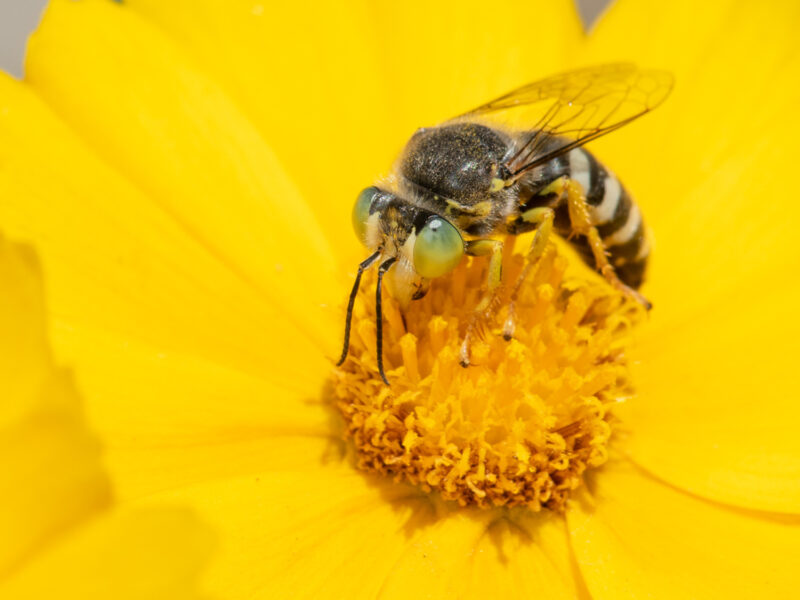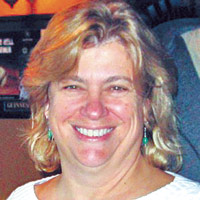

As a beekeeper, I am generally not a fan of wasps. In my experience, they’re carnivorous little brats with a sting that feels like a hammer strike and a taste for honeybees that can lead them to invade and destroy a weak hive.
Heather Holm just changed my mind. Author of four books on wasps and other pollinators, Holm will present a Zoom talk to the Horticultural Alliance of the Hamptons as part of the group’s lecture series. “Native Predatory Wasps — Their Role as Pollinators and Beneficial Insects” will be presented live on Sunday, March 9, at 2 pm.
Holm didn’t start out her career with a passion for the kind of insects most people do their best to avoid. “I actually have more formal training in the plant side of things,” she explains. “But about 20 years ago, I became very interested in pollinators. I joined a study group at the local university and went on a fast and steep learning curve about pollinating insects.
“Since then, I’ve sort of bridged the two disciplines, helping to educate people about plants and the ecology of habitat — making a connection between those flower-visiting insects and the plants they rely on.”
She explains there are two broad categories of wasps in the wild — parasitic and predatory. Wasps are all predatory, in the sense that they all use some kind of insect or spider as the food source for their larvae, but the ones considered parasitic don’t nest at all. They seek out suitable prey and lay an egg or two inside that prey. Some are generalists, while others are species-specific, laying eggs only in hornworms or aphids, for example.
“The second kind, the predatory wasps, that group is really the ancestor of bees,” she says.“The primary difference between bees and wasps is that wasps feed their young a larval diet, and bees feed theirs a plant-based diet. Everything else about the two groups is pretty similar — a majority nest in the ground, a minority in cavities. As adults, most of these solitary wasps are no longer carnivorous; they switch back to a plant-based diet. They look for sugary substances, including flower nectar, plant sap, or honeydew (the sugary waste product of aphids, cicadas and some other insects). So they provide two ecosystem services — pest population control and pollination.”
Holm explains that wasps generally have shorter tongues than bees, so they seek out simpler flowers with easy access to nectar. “Anything in the aster family, goldenrod, mountain mint, white boneset, late-flowering thoroughwort. Even if you have a vegetable garden, you can plant flowers that draw these insects in and provide them with the food resources they need, and in return they’re going to help hunt pests in your vegetable garden. In my presentation, I’ll give the audience tips and tools on what to plant to attract some of these solitary wasps.”
Holm has taken on the role of wasp ambassador, working to educate gardeners and the public in general about the value of the creatures. Most of the time, people are unaware that wasps are even visiting their gardens, as they are generally not aggressive toward people.
Problems arise, however, when our lives intertwine too closely with that of social wasps that live in communities, like ground-nesting yellowjackets, or the paper wasps that build those large round abodes in trees, or sometimes under your eaves.
For instance, if you run your lawn mower over a ground-nesting colony of yellowjackets, it is not going to end well, as the insects will likely pour out of the nest, stingers at the ready, to defend their home. And a large nest of paper wasps over your front door is also likely to lead to unpleasant interactions.
“You need to be observant,” Holm said, “and cognizant of whether you have a social nest in your garden that’s close to human activity and could be potentially harmful to people.”
Finding those nests in the spring, when they’re just getting established, is ideal, because then you’re only dealing with a small number of wasps. “You could have a couple of females that just established a nest in May, and it’s easy to intervene at that point. If that nest is right above your front door, you can just knock it down with a broom, but if you don’t see it until August, then you’ve got a full-size social nest that you really need to watch out for.”
In the case of ground-nesting wasps that can’t be avoided, Holm recommends putting an upside-down bucket over the entrance hole, or holes, and leaving it there for a couple of weeks to starve the wasps. Avoid using pesticides, which will likely end up killing a lot more than just the wasps you’re targeting.
But she is emphatic that in most cases of wasp nests, safety isn’t an issue. “If you have a nest 15 to 20 feet up on a tree branch, that nest can exist the whole growing season without people even knowing it’s there. It’s not going to bother anyone. And those nests are annual, so if you find one in the corner of your yard in August, you can just give it a 15-foot buffer, and by the end of the growing season the wasps will be gone.”
She added: “My husband and I had a yellowjacket ground nest one foot from our walkway all summer last year, and we never had to intervene. My husband and I knew it was there, and neither of us ever got stung. I think it’s really about awareness of where nests are and acting appropriately.”
“Native Predatory Wasps — Their Role as Pollinators and Beneficial Insects” will begin at 2 p.m. on Sunday, March 9, via Zoom. Members of the Horticultural Alliance of the Hamptons will receive the Zoom link to watch Heather Holm’s talk via email ahead of time. Nonmembers who wish to watch can register for $10 at hahgarden.org/tickets.
 More Posts from Lisa Daffy
More Posts from Lisa Daffy